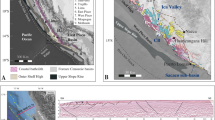Abstract
We studied two sections that accumulated during the Paleocene–Eocene transition in shelf waters in the northeastern Tethys. Stable carbon isotopic compositions of marine and terrestrial biomarkers are consistent with a 13C depletion in the oceanic and atmospheric carbon dioxide pools during the Late Paleocene Thermal Maximum (LPTM; Subzone P5b). The 2–3‰ negative δ 13C excursion in planktic foraminifera coincides with minimum δ 18O values, an incursion of transient subtropical planktic foraminiferal fauna, and the occurrence of an organic-rich sapropelite unit in Uzbekistan, which accumulated at the onset of a transgressive event. Biomarker distributions and hydrogen indices indicate that marine algae and bacteria were the major organic matter sources. During the Late Paleocene (Subzones P4 and P5a), the marginal northeastern Tethys experienced a temperate to warm climate with wet and arid seasons. Most likely, warm and humid climate initiated during the LPTM (Subzone P5b) and subsequently extended during the Eocene (Zone P6) onto adjacent land areas of the marginal northeastern Tethys.
Similar content being viewed by others

Author information
Authors and Affiliations
Additional information
Received: 18 May 1999 / Accepted: 2 February 2000
Rights and permissions
About this article
Cite this article
Bolle, MP., Pardo, A., Hinrichs, KU. et al. The Paleocene–Eocene transition in the marginal northeastern Tethys (Kazakhstan and Uzbekistan). Int Journ Earth Sciences 89, 390–414 (2000). https://doi.org/10.1007/s005310000092
Issue Date:
DOI: https://doi.org/10.1007/s005310000092



